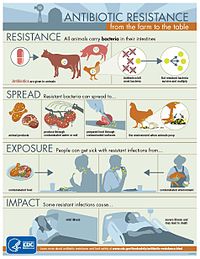
Photo from wikipedia
Rising levels of antibiotic resistance are undermining ecological and human health as a result of the indiscriminate usage of antibiotics. Various resistance mechanisms have been characterized—for example, genes encoding proteins… Click to show full abstract
Rising levels of antibiotic resistance are undermining ecological and human health as a result of the indiscriminate usage of antibiotics. Various resistance mechanisms have been characterized—for example, genes encoding proteins that degrade antibiotics—and yet, this requires further exploration. ABSTRACT Antibiotic resistance mediated by bacterial enzyme inactivation plays a crucial role in the degradation of antibiotics in the environment. Chloramphenicol (CAP) resistance by enzymatic inactivation comprises nitro reduction, amide bond hydrolysis, and acetylation modification. However, the molecular mechanism of enzymatic oxidation of CAP remains unknown. Here, a novel oxidase gene, cmO, was identified and confirmed biochemically. The encoded CmO oxidase could catalyze the oxidation at the C-1′ and C-3′ positions of CAP and thiamphenicol (TAP) in Sphingobium sp. strain CAP-1. CmO is highly conserved in members of the family Sphingomonadaceae and shares the highest amino acid similarity of 41.05% with the biochemically identified glucose methanol choline (GMC) oxidoreductases. Molecular docking and site-directed mutagenesis analyses demonstrated that CAP was anchored inside the protein pocket of CmO with the hydrogen bonding of key residues glycine (G) 99, asparagine (N) 518, methionine (M) 474, and tyrosine (Y) 380. CAP sensitivity tests demonstrated that the acetyltransferase and CmO could enable a higher level of resistance to CAP than the amide bond-hydrolyzing esterase and nitroreductase. This study provides a better theoretical basis and a novel diagnostic gene for understanding and assessing the fate and resistance risk of CAP and TAP in the environment. IMPORTANCE Rising levels of antibiotic resistance are undermining ecological and human health as a result of the indiscriminate usage of antibiotics. Various resistance mechanisms have been characterized—for example, genes encoding proteins that degrade antibiotics—and yet, this requires further exploration. In this study, we report a novel gene encoding an oxidase involved in the inactivation of typical amphenicol antibiotics (chloramphenicol and thiamphenicol), and the molecular mechanism is elucidated. The findings provide novel data with which to understand the capabilities of bacteria to tackle antibiotic stress, as well as the complex function of enzymes in the contexts of antibiotic resistance development and antibiotic removal. The reported gene can be further employed as an indicator to monitor amphenicol’s fate in the environment, thus benefiting risk assessment in this era of antibiotic resistance.
Journal Title: Applied and Environmental Microbiology
Year Published: 2022
Link to full text (if available)
Share on Social Media: Sign Up to like & get
recommendations!